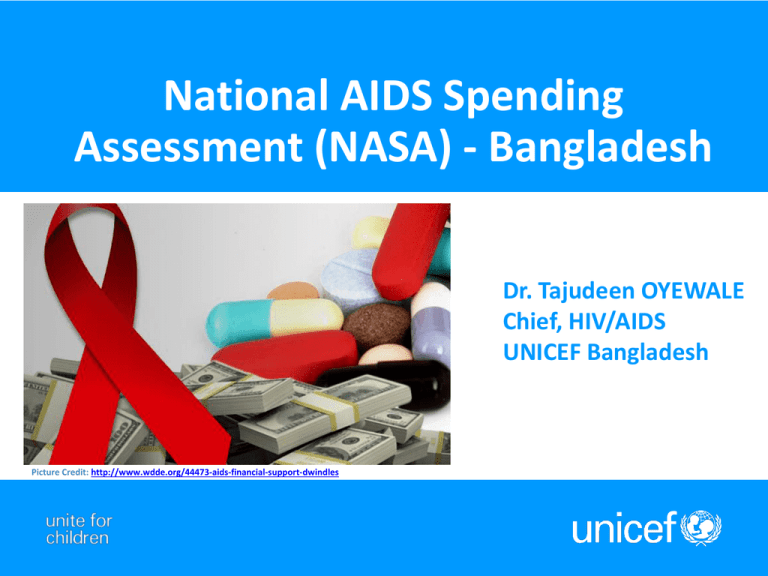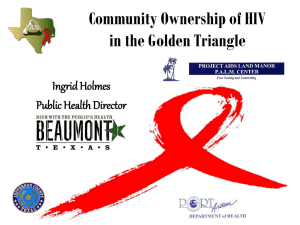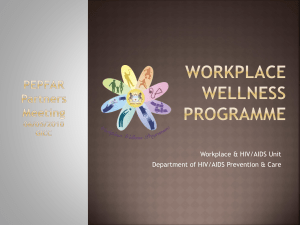
National AIDS Spending
Assessment (NASA) - Bangladesh
Dr. Tajudeen OYEWALE
Chief, HIV/AIDS
UNICEF Bangladesh
Picture Credit: http://www.wdde.org/44473-aids-financial-support-dwindles
Situation of HIV and AIDS in Bangladesh
•
†
•
† Among
National HIV prevalence among the general population is less than
0.1% but concentrated in key population groups (FSW, MSM, PWID &
TG)
key population, HIV prevalence was < 1% in women who sell
sex and MSM, and 5.3% among PWID is 5.3% in a location in Dhaka
• *Estimated Population living with HIV 8,000 (3,100 – 82,000)
• *Children aged less than 14 years with HIV 400 (100 – 2,000)
•
∞35%
of new HIV cases in 2012 were among women and 6% were
among children less than 15 years
† NASP,
2011. The 9th HIV Sero -Survellance in Bangladesh
* UNIADS 2013. UNAIDS Global Report on AIDS. WHO: Geneva
∞ NASP, 2012. HIV and AIDS Situation and Update, 2012.
Trends in HIV Prevalence among Key
Affected Population groups (1989 – 2009)
1
0.9
0.9
0.8
p<0.001
0.8
0.7
0.7
0.7
0.7
0.6
% 0.5
0.4
0.4
0.4
0.4
0.3
0.3
0.2
0.1
0
Round I
(N=1,862)
Round II
(N=3,122)
Round III
(N=3,456)
Round IV
(N=6,515)
Round V
(N=9,073)
Round VI
(N=9,835)
Round
Round VIII
VII(N=10,368) (N=12,786)
Round IX
(N=12,894)
Source: NASP, 2011. The 9th HIV Sero -Survellance in Bangladesh
• According to UNAIDS (2012), Between 2001 and 2011, Bangladesh is
one of the four countries in Asia that have reported 25% increase in
new HIV cases
Adolescents and HIV in Bangladesh
National Size Estimate of Young Key
Population (10 – 24 years) in Bangladesh
Proportion aged
10 – 18 years
Transgender
6,096
33%
MSM/MSW
5,820
10%
Non Injecting Drug
User*
Injecting Drug
Users
Female Sex
Workers
30,409
2,097
21%
37%
31,101
20%
SOURCE: National AIDS / STD Programme, Ministry of Health and Family Welfare Bangladesh. Mapping and Behavioral Study of Most At Risk Adolescents in Specific
Urban / semi urban locations in Bangladesh, 2012.
• Only 13% of all young people (aged 15 – 24 years) have comprehensive
knowledge of HIV prevention (14% among Boys and 12% among Girls) –
(BDHS, 2011)
Aim and Objectives of the NASA
Aim:
• To track the financial flows and expenditures in AIDS
with a view to determining the pattern of expenditure,
allocation, and whether all resources allocated to this
sub-sector reach their intended beneficiaries.
Objectives:
• Provide a current assessment of national AIDS funding
flows and spending for the period 2011-2013
• Identify delays in financial transfers, leakage rates,
and general inefficiencies in spending, if any
Background to the NASA
• Bangladesh remains extremely vulnerable to HIV
epidemic given its poverty, overpopulation, and
gender inequality, high mobility of the population in
country and high level of transactional sex.
• HIV/AIDS program in Bangladesh is funded through
multiple sources.
• There remains limited evidence on how money is
transferred or spent at different levels by sources of
funding and executing agency, by activity and by line
items.
What the study will do?
• Trace the inflow of resources from central
government through different line ministries, and
through development partners and NonGovernment Organizations (NGOs)
• Track the expenditure of fund through
intermediary administrative levels (divisions,
districts, sub-districts) to the service delivery unit
(hospital or clinic) as well as to community level
• Track allocation and expenditure against
thematic areas in the AIDS response
What information on resource flows will
be gathered?
•
•
•
•
•
•
Where do the resources come from?
Where do the resources go?
What kinds of services and goods do they purchase?
Who provides what services and goods?
What inputs are used for providing services?
Who benefits from the spending?
Concept of Bangladesh National Health
Accounts (BNHA): Flow of Funds
BNHA Framework
• Incorporates a health funding dimension (financing
agent) and does not attempt a funding source
classification
• Funds received by government from foreign
development partners treated as government outlay
Framework: NASA Study
Financing agent:
•
•
•
•
•
NASP, Ministry of Health and Family Welfare (MoHFW)
Ministry of Social Welfare,
Ministry of Women and Child Affairs (MOWCA),
Ministry of Labour
Rest of the world
Provider
•
•
•
•
•
•
•
General Administrations of Health
Public Health Programs
Hospitals
Nursing and Residential Care Facilities
Providers of Ambulatory Care
Drug and Medical Goods Retail Outlets
Other
Beneficiaries
•
•
•
•
•
•
•
People living with HIV
Most at risk population
Other key population
Specific accessible population
General population
Non-targeted interventions
Specific targeted population
Thematic areas in the AIDS response
•
•
•
•
•
•
•
•
Prevention
Care and treatment
Orphans and vulnerable children
Programme management and Administration
Strengthening
Incentives for human resources
Social protection and social services
Enabling environment
Research
Methods of Data collection for
the NASA
Preparatory phase:
• A mapping of funding sources who channel resources
to funding agencies will be done
• A mapping of funding agencies who channel
resources to HIV/AIDS programme
• A mapping of providers
• A mapping of beneficiaries
Methods of Data collection for
the NASA
• Preparing draft data collection instrument (DCI)
• A day-long workshop will be arranged to discuss the
draft DCI and to review the overall methodology
adopted for the study – 7th December 2013 at Ascot
Hotel, Baridhara
• Meeting stakeholders to collect information
What information do we need?
From Ministry:
• Amount of fund received in ADP by sources (through
GOB, RPA and DPA)
• Amount of fund received from each Development
partner
• Fund allocated by programme / thematic area
• Fund allocated by line items
• Fund allocated by geographic area (if possible)
What information do we need?
From Development Partners
• Fund allocated to GOB and NGOs
• Fund allocated through RPA and/or DPA
• Fund allocated by programme
• Fund allocated by geographic area (if possible)
• Fund allocated by line items
What information do we need?
From Providers
• Amount of fund received by funding agents (through
GOB, RPA and DPA)
• Amount of fund received from each Development
partner
• Fund received by thematic areas
• Fund received by line items
• Fund received by geographic area (if possible)
What information do we need?
From Providers
• Expenditure by funding agents (GOB, RPA and DPA)
• Expenditure by program thematic areas
• Expenditure by line items
• Expenditure by geographic area (if possible)
• The above information will be collected for the
financial year 2010-2011, 2011-2012 and 2012-2013
Data analysis
• Use of data gathered from multiple sources for
making NASA estimates guided by NHA and NASA
guidelines
• Interpolation and extrapolation in case of data gaps
by applying appropriate guidelines
• Checked trends of various components and
compared for years 2011, 2012 and 2013 (JanuaryJune)
Use of NASA
• Policy tool
– Enable informed policy decisions
– Inform external funders’ decisions
• Monitoring tool
– Monitor progress against targets
– International comparison
– Spending trends
What has been done so far
• A consultant has been hired and the inception report
has been prepared
• Initial discussion has been done with NASP
• A Working Group (WG) has been formed chaired by
the Line Director, NASP
• A draft data collection instrument has been prepared
Time frame
October November December
2013
2013
2013
Signing contract with UNICEF
Initial discussion with UNICEF
Submission of Inception Report
Formation of WG
Developing methodological approach
Developing Data Collection Instrument
Arranging workshop
Data collection
Data analysis and report writing
Finalisation of report
January
2014
Questions and
answers
For more information, please contact
Dr. Tajudeen Oyewale
Rumanah Hugue, PhD
Chief, HIV and AIDS
Associate Professor, Department of Economics
UNICEF Bangladesh
University of Dhaka, Bangladesh
toyewale@unicef.org
United Nations Children’s Fund
Bangladesh Country Office
BSL Office complex
1 Minto Road, Dhaka 1000
Bangladesh
Tel: +88 02 885 2266
www.unicef.org.bd
© United Nations Children’s Fund
December 2013






